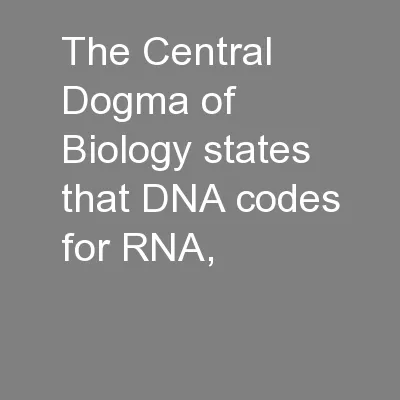

When DNA codes for RNA the process is called TRANSCRIPTION When RNA codes for proteins the process is called TRANSLATION There are 3 types of rna however only mRNA is involved in transcription ID: 425158
Download Presentation The PPT/PDF document "The Central Dogma of Biology states that..." is the property of its rightful owner. Permission is granted to download and print the materials on this web site for personal, non-commercial use only, and to display it on your personal computer provided you do not modify the materials and that you retain all copyright notices contained in the materials. By downloading content from our website, you accept the terms of this agreement.
Slide1
The Central Dogma of Biology states that DNA codes for RNA, and RNA codes for Proteins
When DNA codes for RNA, the process is called
TRANSCRIPTION
. When RNA codes for proteins, the process is called
TRANSLATION
.Slide2
There are 3 types of rna, however only mRNA is involved in transcription
Name
mRNA
rRNAtRNAFunctionCarries genetic information from DNA during TRANSCRIPTION in the nucleus to direct protein synthesisAssociates with protein to form the ribosomeTransports amino acids to ribosomes during TRANSLATION. ExampleSlide3
What is the purpose of Transcription?Where does transcription take place?Slide4Slide5
Let’s Watch Transcription before we examine the steps!http://highered.mcgraw-hill.com/sites/0072507470/student_view0/chapter3/animation__mrna_synthesis__transcription___quiz_1_.htmlSlide6
Transcription Stage 1: Initiation
T
ranscription begins when RNA Polymerase attaches to a PROMOTER on the DNA strand
The promoter determines which of the two DNA strands will serve as the template strand. The promoter indicates where RNA Polymerase can attach to the DNA strandSlide7
A common promoter on the DNA sequence is called the TATA Box. This is around 25 nucleotides from where transcription begins.Slide8
Once RNA Polymerase attaches to the promoter, it unwinds the DNA template strand. RNA synthesis begins moving along the DNA template strand and RNA begins transcribing the DNA template strand. The new strand is created in the 5’ to 3’ direction.
What would RNA Polymerase transcribe from the following promoter sequence?
A C A G G C A T A T A Slide9
TRANSCRIPTION STAGE 2: ELONGATIONRNA Polymerase moves along the DNA strand and continues to unwind the helix.
Polymerase reads the strand and transcribes a complementary mRNA strand.
As polymerases passes over the strand the mRNA peels away and the DNA helix re-forms. Slide10
Stage 3 transcription : TerminationTranscription proceeds until after the RNA polymerase transcribes a terminator sequence in DNA.
Shortly past the termination signal, the mRNA is cut from the Polymerase. Slide11Slide12
How might transcription take place if your body required a large amount of mRNA to be made from a particular gene?Slide13
The mRNA sequence is modified before it leaves the nucleus to enter the cytoplasmThe 5’ end is capped with a modified guanine nucleotide.
Reduces degradation
The 3’ end received 50-250 adenine nucleotides .
Reduces degradation Aids the mRNA in exiting the nucleusA 5’ CAP is added A POLY A tail is addedSlide14
RNA is spliced before it leaves the nucleus. Introns are non-coding regions in the mRNA sequence. They are removed before the mRNA exits the nucleus.
Exons are the coding regions in the mRNA molecule. They are connected to form a complete mRNA strand.
Think: Exons exit the nucleus
INTRONSEXONS